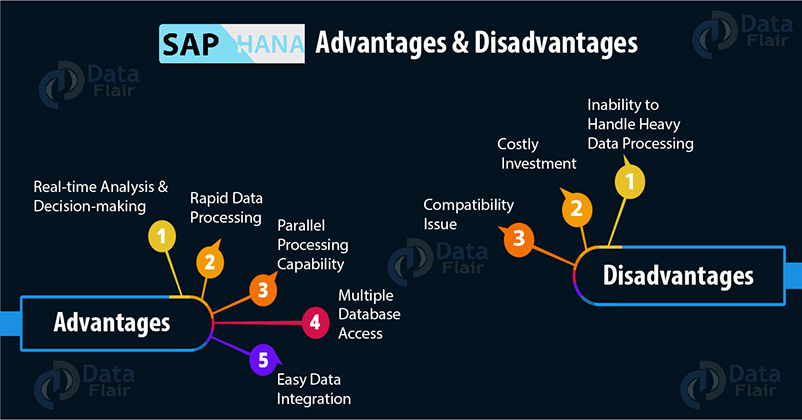FREE Online Courses: Elevate Your Skills, Zero Cost Attached - Enroll Now!
“Every technology has two sides; it is better to look at both before we commit ourselves to either”. The same goes for SAP HANA.
While it is a popular and widely used technology for its unique features, it also has some shortcomings. In this article, we are going to discuss the pros and cons of SAP HANA to shine an unbiased light upon it.
SAP HANA Pros and Cons
Advantages of SAP HANA
Let us start with enlisting the numerous benefits of using the new age technology, SAP HANA:
1. SAP HANA provides real-time analysis and decision-making capability. It enables processing of large amounts of data while the business is going on. Thus, it provides instant real-time insights.
2. The in-memory database technology makes data processing and transactions very fast as the data stores in RAM. Therefore, data can be directly and quickly processed from there.
3. SAP HANA allows data to store and process in columns as well as rows in the database. Also, many operations can be parallelly processed in SAP HANA as opposed to only a single operation processing in the traditional database for executing one query. Thus, parallel processing increases the speed of operation manifold.
4. In traditional database and the technologies working with it, users can use only one of the transactional processes (OLTP and OLAP) at a time. But, in SAP HANA’s in-memory database, you can access various databases both for transactional (OLTP) and analytical (OLAP) queries parallelly at once.
5. You can fetch data from various external data sources due to the source-agnostic capabilities of SAP HANA. Also, it makes the SAP HANA compatible with different DBMS used across the organization. Thus, enabling easy data integration.
6. Without interrupting the ongoing business operations, you can perform data integration and aggregation from various applications and data sources in SAP HANA. You can also integrate it with SAP Business Object BI solutions.
Technology is evolving rapidly!
Stay updated with DataFlair on WhatsApp!!
7. You can store the business insights in a Persistent Data Repository and recover it from here in case of a system break down.
8. By the real-time data replication service, you can replicate the data from SAP ERP into SAP HANA without it’s interjecting with the other operations of the business suite.
9. For third-party application access, you can use applications of SQL and MDX.
10. Using data modeling and designing tools, data models are made very flexible and are completely virtual. It also makes the process of modeling and re-modeling very easy.
11. Business Warehouse Admin Cockpit efficiently manages and monitors the SAP HANA.
Disadvantages of SAP HANA
Now we will discuss some limitations of SAP HANA:
1. SAP HANA is only compatible to and thus will run only on SAP or SUSE Linux certified hardware. It creates an issue for all the users who want to run it on any other kind of hardware as prices of licensing are very high.
2. Limited hardware compatibility makes wanting to use SAP HANA a costly investment.
3. SAP HANA does not support all ERP products because of their different kinds of business architecture. SAP HANA requires ERP users to change their architecture to make it HANA compatible.
4. Due to frequent SPS releases and updates in the SAP HANA versions, the older version gets outdated very soon. And, it might trouble the user at times as they have to purchase the new update every time and updating is time-consuming.
5. Users have reported SAP HANA server shut down at times of heavy data processing and calculation load to it.
6. Using hybrid solutions of HANA like running it partly on the cloud and partly on-premise causes a lot of issues and doesn’t function properly.
7. Usually, developers who still continue with their old ways of working with database technologies, are not able to use SAP HANA to its full potential. They only use it as a fast in-memory database, while there are many other features and functionalities that SAP HANA provides.
Summary
We discussed all the pros and cons of SAP HANA in this tutorial. We hope it helped you in understanding this technology better. Now, you can weigh the advantages and limitations of SAP HANA and choose it, if this database fulfills all your requirements.
Still any confusion? Feel free to drop your queries in the comment section below. We would love to help you.
